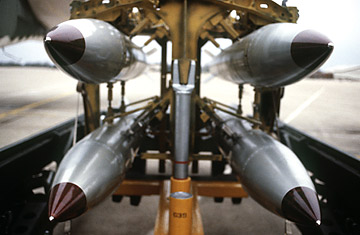
The U.S. stores an estimated 200 B-61 thermonuclear gravity bombs in five European countries
On Nov. 19, the 28 NATO member nations will meet in Portugal to draft a new strategic concept — the document that lays out how the military alliance plans to use its forces to respond to a range of future threats and possible attacks. But while 21st century dangers such as terrorism, piracy, cyberwarfare and rogue nuclear states should be the focus of attention in the run-up to the summit, it's an anachronism that is causing the biggest disagreement: what to do with NATO's tactical nuclear weapons.
The U.S. stores an estimated 200 B-61 thermonuclear gravity bombs in five European countries: Belgium, Germany, Italy, the Netherlands and Turkey. The bombs are considered tactical or battlefield nukes — as opposed to strategic or long-range nuclear weapons — because they are designed to be dropped on attacking armies, not the cities, infrastructure or industry targeted by strategic missiles and bombs. In NATO's case, the sole purpose of the weapons is to fend off the Russian army if it chooses to sweep across Central Europe in a kamikaze invasion.
Because that is now an unlikely possibility, some NATO members — most vocally Germany — have advocated the withdrawal of the weapons, which polls show are unpopular among the populations of their host countries. But Poland and some Baltic nations have expressed concern that rolling back NATO nuclear deployments could undermine the idea of collective security on which the alliance is premised; analysts say they view Russia with suspicion and feel their safety is best guaranteed by a nuclear deterrent spread out among NATO states.
According to various media reports, a draft of the strategic concept currently circulating among member states stops short of calling for the removal of the B-61s. Instead, it includes only a vague commitment to eventual nuclear disarmament. But even that has caused disagreement, as some alliance members fear it will lock NATO into giving up its tactical deterrent in the future. NATO spokesman James Appathurai would not comment on the specifics of the draft or negotiations surrounding it, but he did tell TIME that the issue of tactical nuclear weapons would not be addressed without similar cuts to Russia's tactical arsenal. "The allies look at tactical nuclear weapons in the context of Russia," he says. "While NATO has cut its tactical weapons to the low hundreds, Russia still has thousands of these things. That's of concern to allies. There is an imbalance there."
That sort of rationale frustrates many arms-control experts, who say that Russia is unlikely to eliminate its tactical stockpile because to Russian war planners they are necessary to counterbalance NATO's larger and more powerful conventional forces, and also to protect Russia's long border with China. Hans Kristensen of the Federation of American Scientists, who closely monitors U.S. tactical weapons in Europe, says that U.S., French and British strategic nuclear forces provide more than enough firepower to deter Russian aggression. "NATO needs to get its message straight: Is Russia an adversary for the nuclear weapons deployed in Europe?" he says. "If not, then the weapons should be withdrawn so Europe can get out of the Cold War. Anyone who suggests that Russia would somehow ignore the other considerable conventional and nuclear capabilities if the weapons in Europe were withdrawn needs to see a nuclear therapist."
Kristensen and others point out that the B-61s are also a violation of the spirit of the Nuclear Non-Proliferation Treaty — the 1968 agreement governing nuclear weapons that provides a legal restraint to the ambitions of rogue states. That treaty forbids the transfer of nuclear weapons between countries. But the U.S. has weapons stored on bases owned by other NATO countries, and the weapons are fitted to be used by other countries' warplanes if needed.
There's also concern surrounding the safety of the B-61s, as tactical weapons are a prime target for nuke-seeking terrorists. B-61s are small enough to be transported on a pickup truck. Last year, a U.S. Air Force report found that the European and U.S. bases storing the bombs were failing to meet security requirements to safeguard them.
Last week, 36 former high-level European officials released a statement calling for NATO to "review its entire nuclear policy" — a clear nod to the tactical stockpile — while reminding decisionmakers that "NATO should make disarmament a core element of its approach to providing security" and that "this alliance has always combined deterrence with détente." The statement's signatories included former British Foreign Secretary Margaret Beckett, former British Defense Secretary Des Browne, former European Commission President Jacques Delors, former Dutch Prime Minister Ruud Lubbers and former German Chancellor Helmut Schmidt.
Despite such high-profile support, specific mention of eliminating NATO's tactical nuclear weapons will likely remain out of the strategic concept, says Steve Andreasen, a former director for arms control on the National Security Council and now a lecturer at the University of Minnesota. Andreasen recently co-authored a report on behalf of the London-based military think tank the Royal United Services Institute that laid out a conservative, multistep approach to forging a consensus on the nuclear issue. If such a consensus is ever to be reached, Andreasen says, it will take time — and a strong guiding hand. "It is crucial for that review to be properly framed from the outset, with a clear direction in support of further reductions [in tactical weapons] — and, that the review itself be conducted under high-level political direction," he says. "In short, progress will require a little more leadership, a little less lethargy."
